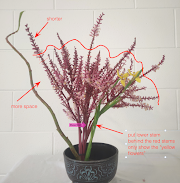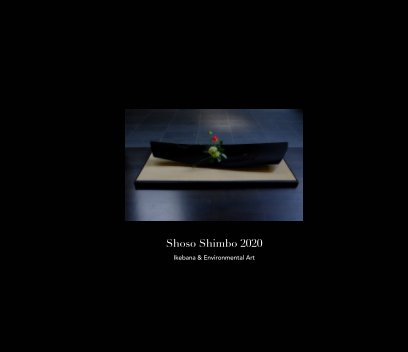Beyond Design Principles- Level 3.7 Form X Contrast (30 November 2024)
When: (Melbourne, Australia Time) Check your local time.
9:00-9:30AM 2:00 - 2:30 PM (AEDT), 30 December 2024
New Level 1 Course to start in January 2025 :
Application opens in December 2024. Book from our Schedule page.
Visit our Curriculum page to find out why our one-year Ikebana Dojo program would help all ikebana students and teachers.
Monthly Ikebana Challenge
Level 3.7. Form X Contrast
Always remember that you are aiming to go beyond simply designing an ikebana work to create ikebana through meditation. Following the three-step learning model is recommended: start with a small aspect of design (Form X Contrast in this session), think deeply about all aspects of design until new ideas emerge, and then follow the direction of your new ideas to find poetry in your work.
During this kind of creative meditation, it is hoped that you will be able to learn to “talk to the flowers” rather than thinking about designs analytically (Refer to Shoso's essay, A Flower Arrangement in Search of Poetry).
In this session, 3.7: Form X Contrast, please start making one or more massed forms using stems, branches or vines. It is recommended (but not necessary) to manipulate (cut, fold, twist, weave etc.) and transform the original shape of the materials. Then, apply the principle of contrast. The forms you created may include contrast in themselves and you may develop your design from there.
Alternatively, you may introduce other elements to create contrast, although this approach is not the focus of this session.
Remember that contrast is about the degree of visual difference between the elements of a composition as a means of emphasis, for example, dark and light tones, warm and cool colours, or high and low density.
We also learned that to create strong contrast you should emphasise a difference while maintaining some similarities between the two elements (Zoom Ikebana Dojo, Contrast 1). Contrast emerges when the two elements are different but related. In this sense, creating high & low density using a single material is not just important but also easy to understand.
Of course, good ikebana works contain many types of contrast to create poetry but note that degrees of contrast vary from stark contrast to subtle contrast.
If your work has high contrast in every element (colour, texture, tone, density etc.), your work may be "strong" but may not be very poetic. Good ikebana works usually combine high contrast in one or two elements with low contrast in the other elements.
Managing degrees of contrast is an advanced skill in ikebana aesthetics. In this session, create a massed form with contrast, and meditate how other types of contrasting elements affect your work. This level of thinking & judgement will require you to meditate deeply and ask your flowers for answers. Analytical or technical thinking alone will not provide the answers to your questions, and you might become confused and frustrated (Refer to Shoso's essay, A Flower Arrangement in Search of Poetry).
Once you have learned to talk to your flowers, practice ikebana many times so that it will be a part of your life. We are preparing a practical project (1000 Ikebana Challenge) for those who complete our Zoom Ikebana Dojo, Level 3.
Process of Creative Meditation in Form X Contrast
- Make one or more massed forms using branches (vines or stems).
- Do your forms have High & Low density (contrast) in themselves?
- Is the contrast in your forms strong? (Do you want to make it a strong and main feature?) Then, you should not introduce many other strong contrasting elements in your work.
- Is the contrast in your forms weak? (Do you want to make it a supporting role in your work?) Then, you may consider introducing more stronger contrasting elements.
- In some cases, the contrast in your forms may be weak but you may wish to give it a major role. Find ways to manage other contrasting elements.
- Introduce other elements (line, form, space or colour). Do they work harmoniously with the contrast you created first? Review what you learned in Four Ikebana Elements in Zoom Ikebana Dojo.
- Check your work in terms of other design principles, i.e., movement, contrast and pattern. Review what you learned in Four Ikebana Principles in Zoom Ikebana Dojo. You may not be able to apply all of the principles but trying to incorporate some of them may help improve your work.
- Meditate on your work with your selfless mind, without thinking about designs. Make adjustments to reveal a new life (harmony or poetry) in the arrangement.
- In some Ikebana workshops, you may hear comments such as "you failed because you did not show contrast well." That is not our approach. We value design but we aim to go beyond design. In Level 3 our goal is to achieve harmony, which is higher than design in our definition.
What's Next? - Get Feedback
1. Book to join Zoom Ikebana Dojo by the deadline. That is the first step. Follow the instruction on the page (Schedule Page).
2. After receiving confirmation of your booking, we send you links to access our video tutorial & our Zoom session. Our detailed video (members only) will help you analyse sample works, and help you make your Ikebana work.
3. Make your own work and send the image of your work to Zoom Ikebana Dojo (ikebana.dojo@gmail.com).
4. Join Zoom Ikebana Dojo. Enjoy friendly feedback from our facilitator and other participants.
5. Rework your ikebana after the Zoom session.
6. Post your work to Ikebana Gallery Award.
References
Shimbo, S. (2021). Ikebana: Flower Arrangement in Search of Poetry, Garland Magazine.





















